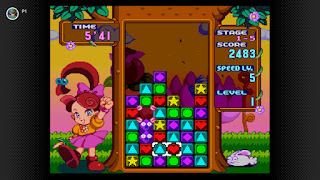Panel de Pon
Originally released in the West with a massive redesign as Tetris Attack, Panel de Pon was destined to be ignored by me for quite a while. Drop-block puzzle games that weren't actually Tetris didn't really interest me for a long time. It wasn't until I played the Puyo Puyo Tetris demo with my wife that I realized playing Puyo Puyo (or other similar titles) could be fun too. I still wouldn't actually play Panel de Pon for years after that, but it's thanks to Puyo Puyo that I opted to give this game a chance in the first place. Plus, I can be a sucker for games that only released in Japan.
Panel de Pon is pretty straightforward. The board follows the typical rules of a match-3 game, clearing any blocks that match in color and form a contiguous line of three or more, with the game ending if any blocks make it to the top of the screen. As expected, the required block matches don't tend to happen naturally. You are provided with a cursor that is two tiles wide. As full lines of blocks slowly rise up from the bottom of the screen, you can use your cursor to swap the horizontal location of two adjacent blocks in order to line up matches. Because your swapping power is limited to the horizontal plane, a lot of your block manipulation will likely involve taking advantage of the board's gravity to encourage vertical movement. Apparently, people can also set up combos to trigger multiple clears in a row, but I will need a lot more practice to do anything like that. Once you get used to the mechanics, likely through solo free play, you'll be ready to take on my favorite part of this game.
Similar to what games like Puyo Puyo Tetris are still offering today, Panel de Pon has a sort of story mode that challenges you with beating an increasingly difficult group of NPC's in a competitive version of the puzzle game. This competitive version lets you spawn garbage blocks on your opponent's board by making large matches or big combos. These garbage blocks turn into regular blocks if a successful match touches them, making them available for clearing as well. The story mode ends up being pretty basic, but it is the perfect motivation for continuing to play and improve in a game that otherwise has no clear end goal. With so many games on my plate already, I like when a game lets me know that I've played enough to comfortably move on, and Panel de Pon does that for me. This approach does end up making the game pretty short, but I don't really mind. There are plenty of sequels to let me hone my craft in the future.
I have recently heard Panel de Pon touted as the best puzzle game of all time, and while I am still firmly a Tetris fan, I can see why people think that. This game has a lot of the same appeal that Puyo Puyo does for me, with colorful characters and a rewarding learning curve. I just don't have the attention span to work through that whole curve in one game. Maybe over time I will try to improve by playing subsequent entries, but for now, I'm just glad I started playing the series here.
The game is available for Switch here (as of 7/7/21): https://www.nintendo.com/games/detail/super-nintendo-entertainment-system-nintendo-switch-online-switch/




